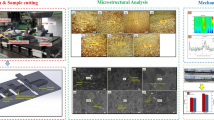Abstract
Earlier studies of Nextel 610 (seeded sol-gel-derived AI2O3 multifilament tow developed by 3M) rein-forced Al-224.2 composite panels manufactured by pressure infiltration casting revealed interface delamination as a result of precipitation of the equilibrium θ precipitate and preferential growth at fiber/matrix interface sites. As a result, strengths as high as 91% of rule of mixtures (ROM) were observed. 75 % ROM strengths were observed after extended heating at 350 °C and hencein situ coarsening of the interface θ precipitates. Transverse specimens displaying this still acceptable tensile strength exhibited values of 490 MPa (approaching that of wrought 2xxx alloys). This combination of high axial and transverse strengths from material in the same condition represents a significant improvement in this class of materials. This process is termed “discontinuously coated interfaces” (DCITM). In the present study, the kinetics of the coarsening process were measured at 350 and 400 °C using a new algorithm for the quantitative metallography determinations of the particle distribution at the interface. The interfacial θ coarsening kinetics follows a classical t1/4 rate law. However, the particle size distribution is contrary to the theoretical predictions. Axial flexure tests on materials subjected to heat treatments at 350 and 400 °C producing close particle sizes result in similar flexure strengths. Thus, it has been demonstrated that the precipitate size and hence distribution at the interface is the most important factor controlling the mechanical properties of the composite.
Similar content being viewed by others
References
V. Gupta, A.S. Argon, and J.A. Cornie,J. Mater. Sci., Vol 24, 1989, p 2031–2040
J.A. Cornie, A.S. Argon, and V. Gupta,Mater. Res. Soc. Bull., Vol 16 (No. 4), Apr 1991, p 27–28
J.A. Cornie, M.L. Seleznev, M. Ralph, and F.A. Armatis, Jr., Im- proving Mechanical Properties of Nextel 610 Reinforced Al-224 Alloy through 6 Phase Precipitation at the Fiber/Matrix Inter- face: Part 1,J. Mater. Sci. Eng., in press
P.P. Bansal and A.J. Ardell,Metallography, Vol 5, 1972, p 97–111
P.J. Wray, O. Richmond, and H.L. Morrison,Metallography, Vol 16, 1983, p 39–58
H.I. Aaronson, C. Laird, and K.R. Kinsman, “Mechanisms of Diffusional Growth of Precipitate Crystals,” inPhase Transfor-mations, ASM Seminar Proceedings, Oct 12 and 13, 1968, p 313–390
H.B. Aaron and H.I. Aaronson,Acta Metall., Vol 16, 1968, p 789
A.J. Ardell, On the Coarsening of Grain Boundary Precipitates,Acta Metall, Vol 20, 1972, p 601–609
Author information
Authors and Affiliations
Rights and permissions
About this article
Cite this article
Seleznev, M.L., Cornie, J.A. & Armatis, F.A. Improving mechanical properties of nextel 610TM- reinforced AI- 224 alloy through θ phase precipitation at the fiber/matrix interface: kinetics of the precipitation process. JMEP 2, 347–352 (1993). https://doi.org/10.1007/BF02648821
Issue Date:
DOI: https://doi.org/10.1007/BF02648821




